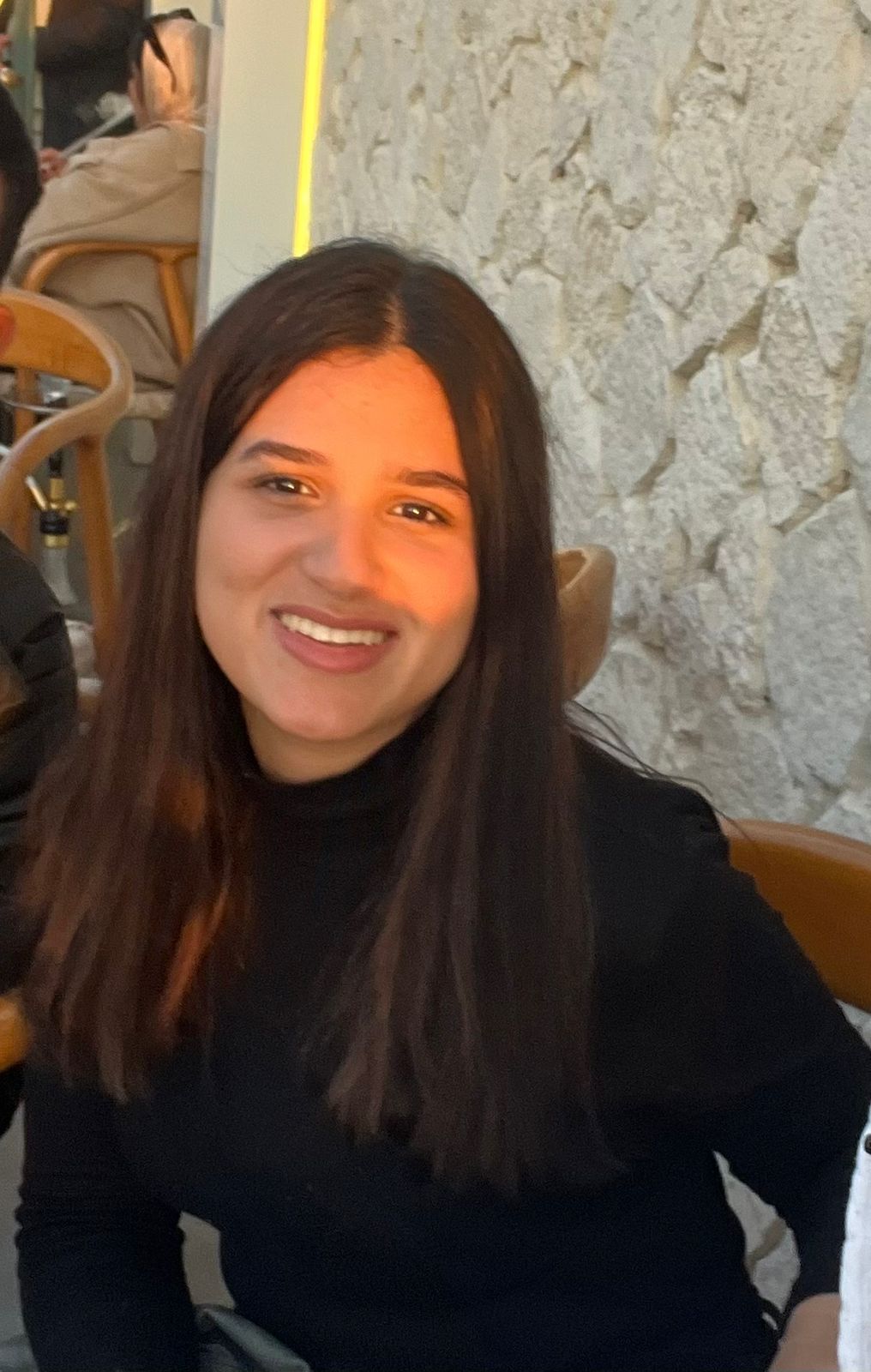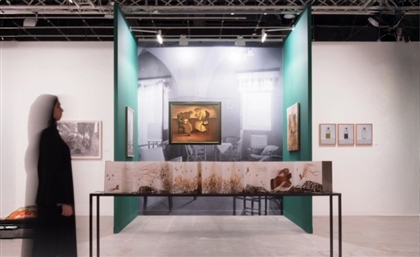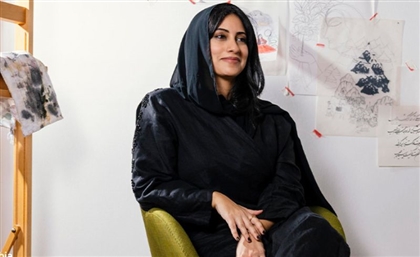Contemporary Artist Armen Agop is Carving Silence in Stone & Souls
Egyptian artist Armen Agop is a quiet force in contemporary art, drawing on the desert, tradition and personal ritual to craft works that ask the viewer to slow down and contemplate.

In the hushed corridors of a near-empty Cairo museum, a teenage boy would slip past indifferent guards to sit cross-legged before a Van Gogh. Not a reproduction, but the real thing; brushstrokes thick with, as he saw it, anxiety and desire. For hours, he’d study how light clung to poppy flowers that he could tell weren’t really about flowers, but about fighting depression. The guards would shift, perplexed by this intense communion. "They’d come tell me, ‘You can’t sit there - that furniture is exhibited.’ As if the chairs mattered more than the paintings," Armen Agop recalls, the memory vivid years later. "But those afternoons... they were my first lessons in how art breathes. How a single painting can hold a universe." This intimate, almost furtive relationship with artistic essence would define his life’s work - a quest to embody the profound silence at the core of human experience.
Today, that boy is one of the most quietly radical artist of his generation. Born in Cairo to Armenian parents and now based in Italy, Armen Agop has spent the last two decades shaping a contemplative practice that refuses the chaos of the moment. His sculptures, rendered in black granite and stainless steel, are invitations to stillness. His ink drawings - meticulously built dot by dot - echo breath, rhythm and repetition.-2e386ad1-41b2-4e84-8e99-adac27c11b20.png) Agop’s work has won the Prix de Rome, the Umberto Mastroianni Award and the Italian Presidential Medal. But awards aren’t what animate his practice. What matters is the unseen: the internal energy a piece transmits, the spirituality it silently embodies. For Agop, form isn’t decorative or narrative. It’s a threshold. “A sculpture,” he says, “is not a story, I do not have messages in my pieces. It’s a presence."
Agop’s path was carved early. At 15, skipping school to haunt a Downtown Cairo studio shared by art students, he encountered a forgotten lump of clay. "That’s my first theft," he confesses. That gritty intimacy with raw material became foundational. He entered Helwan University’s Fine Arts faculty already certain sculpture was his language. But academia chafed. During his first life-model class, a renowned professor began critiquing his unfinished clay portrait. Agop stopped him. "Sir, I haven’t finished yet." The professor exploded. "What? You think you’re better than us?" Agop waited outside the gates that evening, determined to explain: "If I change my work for every professor’s opinion, it becomes theirs. I need to see what I can see first - even if it’s wrong." This fierce insistence on inner truth over external validation became his compass.
Agop’s practice has always stood outside the noise. He speaks of identity as a quiet backdrop to an inner search. Even in his early 20s - at a time when many artists still look outward for cues - he was already resisting the gravitational pull of surface-level storytelling.
His rebellion led him literally to the desert’s edge - a studio in 6th of October City, when it was still sand-swept emptiness. Here, granite chose him. "Marble is beautiful, but it sings too easily. Granite… it’s neutral. It demands honesty." Working the dense stone, a revelation emerged. Traditional sculptures demanded fixed bases, static poses echoing ancient Egyptian gods or European heroes. Agop’s hands, however, felt the stone’s latent movement. Turning a piece mid-carving, he noticed it rocked. "I started leaving them like that - free. No pin, no base. They could breathe."
That clarity eventually shaped the works he became known for. His Touch series - tactile sculptures of dark granite, inviting to the hand as much as the eye - epitomises this shift. With forms so precise they seem almost effortless, the sculptures blur the boundary between weight and levity, presence and potential. “Touch is very simple,” he explains. “It’s a piece of granite, and it moves. But to make granite move, it has to be extremely precise.” Precision, in this case, becomes a kind of devotion.
"Ancient statues command awe. Mine are companions. You touch them, they answer. It’s a conversation." This kinetic intimacy shattered centuries of sculptural hierarchy. The desert, ever-present, deepened his vision. "People talk about Pharaonic lines, but it’s deeper. It’s the desert’s stillness - that horizon where light fractures and creates illusions. You learn patience. You learn to see the subtle shifts within apparent emptiness."
Decades later, another profound shift occurred. Dust from sculpting granite forced him to find a separate painting studio. Here, almost by accident, the Mantra series emerged. Using an architect’s 0.1mm Rapidograph pen, a tool designed for precision drafting, he began making tiny, identical dots on vast black canvases. "For hours, days, weeks… just the same gesture. Over and over. An hour in, you see nothing. Just black. Slowly, through accumulation, light emerges." He calls it "gestural mantra," a physical analogue to spiritual repetition. "It’s not about depicting light. It’s about the process of light fighting through darkness. Like prayer - you don’t rush it. You surrender to the rhythm." The drawings appear as soft textures at a distance, yet up close reveal an obsessive, delicate rhythm: dot by dot, moment by moment.
The painstaking process, taking months per canvas, mirrors his Sufi series sculptures: perfectly spherical granite forms, each polished to a half-light he describes as hermits. "They’re not lonely. They’re complete. The repetition in creating them, like the Sufi dancer’s turn. It’s transcendence. It’s about finding the infinite within the singular." This philosophy crystallised during an exhibition when a viewer made an extraordinary request: "Can you lock me in the gallery alone with them? Just for an hour?" Agop, bewildered but trusting, agreed. "Afterwards, he said he’d meditated.”
His newer series, Transcontemporary, offers a framework for how he sees time as a confluence. "It’s not about past or future," he explains. "It’s about a state of mind that is timeless." The sculptures in this body of work feel both ancient and futuristic, like objects dug out of an excavation yet shaped by some post-human consciousness. They carry the humility of handmade things, and the intensity of thought honed over decades.
The dominance of black in his paintings and preference for unpolished granite’s darkness isn’t an expression of nihilism. "It’s not about the colour itself. It’s about the light you pull from it. Like a candle in a dark room - its power isn’t diminished, it’s intensified." His granite pieces transform under shifting light. "Morning sun on a curve creates a sharp line, a defined edge. By afternoon, it’s soft, diffuse. The stone isn’t changing. The light dancing on it is. The sculpture holds the potential for infinite moments." This resonates with his rejection of AI art’s sterile perfection. "A perfect simulation of Van Gogh's poppies lacks the artist's tremor, his despair, his hope. The uneven density of dots in a Mantra painting—that’s life. Perfection is a tomb."
Agop’s work has won the Prix de Rome, the Umberto Mastroianni Award and the Italian Presidential Medal. But awards aren’t what animate his practice. What matters is the unseen: the internal energy a piece transmits, the spirituality it silently embodies. For Agop, form isn’t decorative or narrative. It’s a threshold. “A sculpture,” he says, “is not a story, I do not have messages in my pieces. It’s a presence."
Agop’s path was carved early. At 15, skipping school to haunt a Downtown Cairo studio shared by art students, he encountered a forgotten lump of clay. "That’s my first theft," he confesses. That gritty intimacy with raw material became foundational. He entered Helwan University’s Fine Arts faculty already certain sculpture was his language. But academia chafed. During his first life-model class, a renowned professor began critiquing his unfinished clay portrait. Agop stopped him. "Sir, I haven’t finished yet." The professor exploded. "What? You think you’re better than us?" Agop waited outside the gates that evening, determined to explain: "If I change my work for every professor’s opinion, it becomes theirs. I need to see what I can see first - even if it’s wrong." This fierce insistence on inner truth over external validation became his compass.
Agop’s practice has always stood outside the noise. He speaks of identity as a quiet backdrop to an inner search. Even in his early 20s - at a time when many artists still look outward for cues - he was already resisting the gravitational pull of surface-level storytelling.
His rebellion led him literally to the desert’s edge - a studio in 6th of October City, when it was still sand-swept emptiness. Here, granite chose him. "Marble is beautiful, but it sings too easily. Granite… it’s neutral. It demands honesty." Working the dense stone, a revelation emerged. Traditional sculptures demanded fixed bases, static poses echoing ancient Egyptian gods or European heroes. Agop’s hands, however, felt the stone’s latent movement. Turning a piece mid-carving, he noticed it rocked. "I started leaving them like that - free. No pin, no base. They could breathe."
That clarity eventually shaped the works he became known for. His Touch series - tactile sculptures of dark granite, inviting to the hand as much as the eye - epitomises this shift. With forms so precise they seem almost effortless, the sculptures blur the boundary between weight and levity, presence and potential. “Touch is very simple,” he explains. “It’s a piece of granite, and it moves. But to make granite move, it has to be extremely precise.” Precision, in this case, becomes a kind of devotion.
"Ancient statues command awe. Mine are companions. You touch them, they answer. It’s a conversation." This kinetic intimacy shattered centuries of sculptural hierarchy. The desert, ever-present, deepened his vision. "People talk about Pharaonic lines, but it’s deeper. It’s the desert’s stillness - that horizon where light fractures and creates illusions. You learn patience. You learn to see the subtle shifts within apparent emptiness."
Decades later, another profound shift occurred. Dust from sculpting granite forced him to find a separate painting studio. Here, almost by accident, the Mantra series emerged. Using an architect’s 0.1mm Rapidograph pen, a tool designed for precision drafting, he began making tiny, identical dots on vast black canvases. "For hours, days, weeks… just the same gesture. Over and over. An hour in, you see nothing. Just black. Slowly, through accumulation, light emerges." He calls it "gestural mantra," a physical analogue to spiritual repetition. "It’s not about depicting light. It’s about the process of light fighting through darkness. Like prayer - you don’t rush it. You surrender to the rhythm." The drawings appear as soft textures at a distance, yet up close reveal an obsessive, delicate rhythm: dot by dot, moment by moment.
The painstaking process, taking months per canvas, mirrors his Sufi series sculptures: perfectly spherical granite forms, each polished to a half-light he describes as hermits. "They’re not lonely. They’re complete. The repetition in creating them, like the Sufi dancer’s turn. It’s transcendence. It’s about finding the infinite within the singular." This philosophy crystallised during an exhibition when a viewer made an extraordinary request: "Can you lock me in the gallery alone with them? Just for an hour?" Agop, bewildered but trusting, agreed. "Afterwards, he said he’d meditated.”
His newer series, Transcontemporary, offers a framework for how he sees time as a confluence. "It’s not about past or future," he explains. "It’s about a state of mind that is timeless." The sculptures in this body of work feel both ancient and futuristic, like objects dug out of an excavation yet shaped by some post-human consciousness. They carry the humility of handmade things, and the intensity of thought honed over decades.
The dominance of black in his paintings and preference for unpolished granite’s darkness isn’t an expression of nihilism. "It’s not about the colour itself. It’s about the light you pull from it. Like a candle in a dark room - its power isn’t diminished, it’s intensified." His granite pieces transform under shifting light. "Morning sun on a curve creates a sharp line, a defined edge. By afternoon, it’s soft, diffuse. The stone isn’t changing. The light dancing on it is. The sculpture holds the potential for infinite moments." This resonates with his rejection of AI art’s sterile perfection. "A perfect simulation of Van Gogh's poppies lacks the artist's tremor, his despair, his hope. The uneven density of dots in a Mantra painting—that’s life. Perfection is a tomb."-5592e0a6-9972-4d41-baf8-1ced7df52bc3.png) Armen Agop’s work is an antidote to a fractured world. "We drown in noise, in flashing images demanding instant reaction. My sculptures, my paintings… they are rafts. Sit with them. Breathe. Touch the stone. See how the light changes when you move. Remember what it is to be present." His journey - from the solitary boy in the Cairo museum to the artist whose silent granite forms command global contemplation - is a testament to the power of inward focus. "The desert doesn’t hurry," he observes, a final, quiet manifesto. "It simply is. Why should we be any different?" In his studios, whether surrounded by Cairo’s chaos or Tuscan marble dust, the act of creation remains a pilgrimage into silence, each chisel strike or inked dot a step towards the essential light within the dark.
In a world entranced by immediacy of answers, of outcomes, of spectacle - Armen Agop has chosen stillness as a stance, creating sculptures that wait. And his drawings, repeated with a meditative hand until the wrist swells, are closer to prayer than gesture. “I’m not interested in expressing myself,” he says plainly. “I’m interested in exploring myself. I’m here to disappear in the work.”
Armen Agop’s work is an antidote to a fractured world. "We drown in noise, in flashing images demanding instant reaction. My sculptures, my paintings… they are rafts. Sit with them. Breathe. Touch the stone. See how the light changes when you move. Remember what it is to be present." His journey - from the solitary boy in the Cairo museum to the artist whose silent granite forms command global contemplation - is a testament to the power of inward focus. "The desert doesn’t hurry," he observes, a final, quiet manifesto. "It simply is. Why should we be any different?" In his studios, whether surrounded by Cairo’s chaos or Tuscan marble dust, the act of creation remains a pilgrimage into silence, each chisel strike or inked dot a step towards the essential light within the dark.
In a world entranced by immediacy of answers, of outcomes, of spectacle - Armen Agop has chosen stillness as a stance, creating sculptures that wait. And his drawings, repeated with a meditative hand until the wrist swells, are closer to prayer than gesture. “I’m not interested in expressing myself,” he says plainly. “I’m interested in exploring myself. I’m here to disappear in the work.”
- Previous Article Villages Painted by Women Across the Middle East & North Africa
- Next Article Six Unexpected Natural Wonders to Explore in Egypt



























